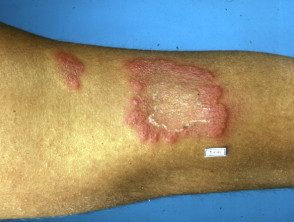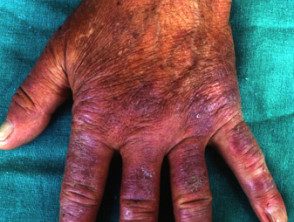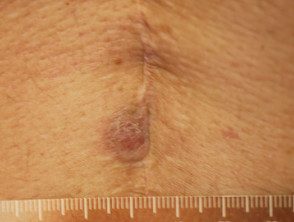What is it erythema elevatum diutinum?
Erythema elevatum diutinum (EED) is a rare type of necrotizing vasculitis characterized by red, purple, brown, or yellow papules (high point), platesor nodules, found on the back of the hands, other extensor muscle overlapping joint and buttock surfaces.
Erythema elevatum diutinum

Erythema elevatum diutinum

Erythema elevatum diutinum

Erythema elevatum diutinum
Who gets erythema elevatum diutinum?
EED can occur in any age group, but patients are usually in their 30s and 60s. It also occurs in men and women.
What is the cause of erythema elevatum diutinum?
EED is classified as a small vessel vasculitis. The cause of EED is not yet defined, but has been associated with the following conditions:
- Granuloma facial
- Recurrent bacterial infections (especially streptococci)
-
Viral infections (included hepatitis B and HIV)
- Hematological diseases
- Rheumatologic diseases
What are the clinical characteristics of erythema elevatum diutinum?
- Lesions generally start as papules or nodules on the back of the hands.
- Other affected extensor surfaces include knees, elbows, wrists, ankles, fingers and toes. The buttocks, trunk, forearms, legs, palms, and soles can also be affected.
- Injuries to the face are indistinguishable from facial granuloma.
- Lesions usually appear symmetrically.
- The color of the lesions progresses over time from yellow or pink to red, purple, or brown.
- Lesions can enlarge during the day and return to their original size at night.
- Rarely, blisters and ulcers can form
- Lesions generally feel firm and move freely over the underlying tissue.
- EED can be asymptomatic or painful, or itchy or burning.
- Symptoms may worsen after exposure to cold.
- Arthralgia may be present.
How is erythema elevatum diutinum diagnosed?
Skin biopsy It is the most important test to establish a diagnosis of EDD; shows leukocytoclastic vasculitis See erythema elevatum diutinum pathology.
Direct immunofluorescence It is useful to confirm the presence of a type of immunocomplex vasculitis.
What is the treatment for erythema elevatum diutinum?
EED is a chronic and progressive skin disease that can last up to 25 years. However, in some cases, after evolving over a period of 5 to 10 years, it may disappear spontaneously.
Medication can be used to limit the progression of the disease.
Dapsone is considered the drug of choice for EED, mainly due to its rapid onset of action and clinical experience has shown good responses. However, the lesions recur immediately after withdrawal of the drug.
Other drugs that have occasionally been reported as effective include:
- Niacinamide
- Colchicine
- Hydroxychloroquine
- Clofazimine
-
Cyclophosphamide
Oral corticosteroids are generally ineffective.
What is the result for erythema elevatum diutinum?
EED generally persists for months, years, or decades. It often recurs after apparently successful treatment.
